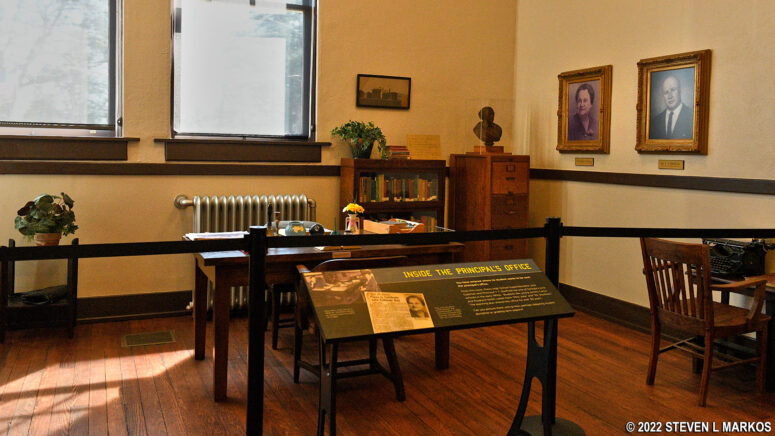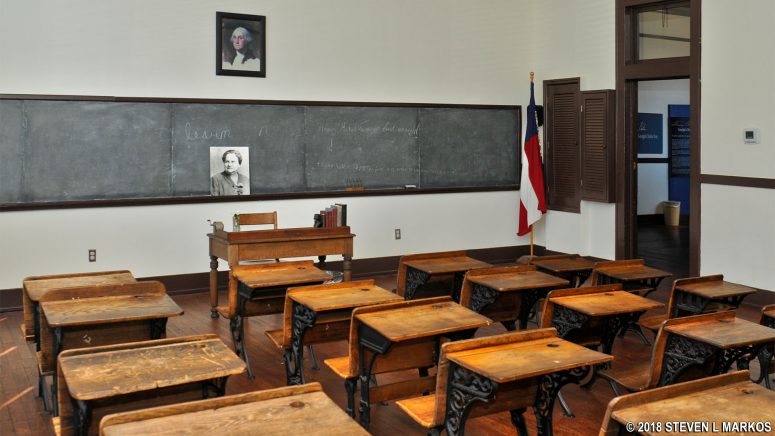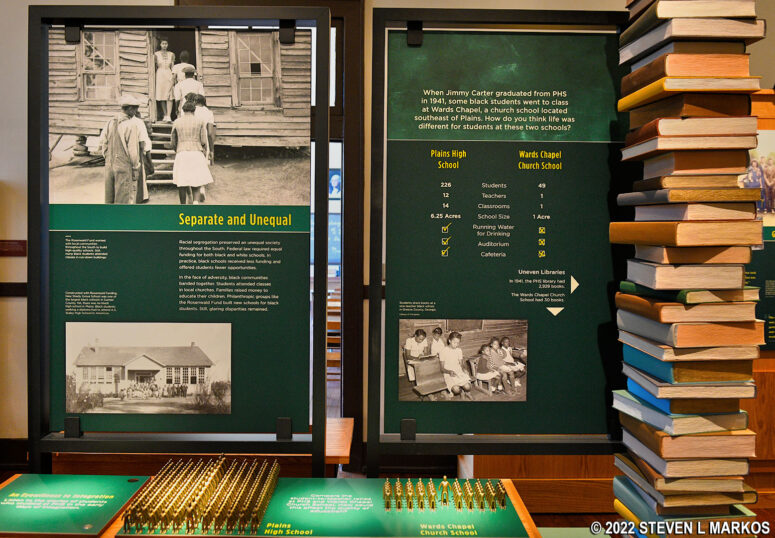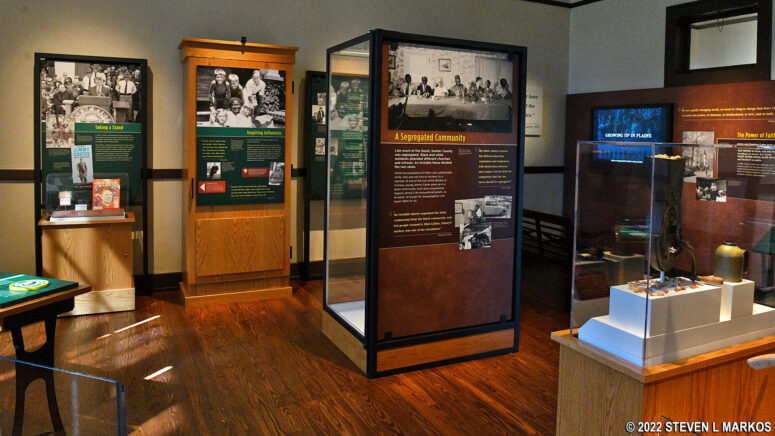GENERAL INFORMATION
The Visitor Center for Jimmy Carter National Historical Park is housed inside the Plains High School building. This is the high school that Jimmy Carter and every other kid in Plains would have attended from 1921 until 1979 when it was closed.
OPERATING HOURS
The Plains High School Visitor Center is open daily from 9 AM to 5 PM, except when closed on Thanksgiving, Christmas, and New Year’s days. Times can always change, so before heading out to the park, be sure to get the latest schedule on the National Park Service’s Operating Hours and Seasons web page for Jimmy Carter National Historical Park.
AMENITIES
- Information desk where you can pick up a map of the park
- Small souvenir and gift store
- Plains High School / Jimmy Carter Museum
- Theater in the school auditorium
- Restrooms

Book and souvenir store at the Plains High School Visitor Center, Jimmy Carter National Historical Park
PARK FILM
An excellent 25-minute film about Jimmy Carter is shown on demand in the school auditorium—just ask a Ranger or volunteer to start it for you. There is no objectionable material, so the film is suitable for all ages.
Nothing has changed about the auditorium since the school closed. I know this because I had the opportunity to spend an hour talking with a National Park Service volunteer who went to school with Jimmy Carter’s sons back in the late 1950s and early 1960s, a time when Jimmy and his family were just ordinary citizens of rural Plains.
PLAINS HIGH SCHOOL / JIMMY CARTER MUSEUM
Plains High School was the only school in Plains, Georgia, with grades 1-12 attending. At any given time—including today—there were never more than 1,000 residents of Plains, so graduating classes have always been small, perhaps twenty or so students. When I asked how twelve grades could have gone to school in the building when there were less than twelve rooms on display, I was reminded that the school was two stories and only the bottom floor is open to the public. The upper level is now used for storage.
In 1979, Sumter County consolidated schools and Plains High School was closed, sending Plains’ kids to nearby Americus where they attend school to this day. The building sat empty until residents started a campaign to renovate it in the late 1980s, with the National Park Service taking over in 1987. Much of the renovation is the direct result of a phone call from Jimmy Carter himself. When it came time to put in a new heating and air system, install new windows, or fix the walls, all of which cost more than the funds available, Carter bypassed the local vendors and went straight to the product manufacturer and got the necessary equipment donated.
Today, much of the first floor of the high school is a museum dedicated to student life in a small town and the career of Jimmy Carter. This is a newly renovated museum that opened in 2021, replacing the old exhibits that focused as much on Plains High School as it did Jimmy and Roselyn Carter (today it’s more Carter than High School). It is divided into multiple rooms, each with a particular historical focus. A tour of the museum starts in the principal’s office and a classroom that are furnished per the time period.
Being a new museum, of course there is now a large focus on racial issues such as school segregation and how it affected Plains and other schools in Sumter County. Exhibits, which are mainly information panels populated with old photographs (many colorized for some reason), start off discussing the situation in the late 1930s and early 1940s when Jimmy Carter and Roselyn Smith attended school. Information panels show the differences between white student life and black student life. The topic of school segregation in the 1950s and 60s is also covered. Other topics include some of the favorite teachers at Plains High School and Roselyn Carter’s high school career (she was valedictorian when she graduated in 1944).

Exhibit on school segregation in the 1950s and 60s in the south, Jimmy Carter National Historical Park
The rest of the museum covers the life and career of Jimmy and Roselyn Carter. The first exhibit room is called A Local Community, and it focuses on Jimmy Carter’s early childhood and adult life and the start of his political career on the local and state level. There is a 5-minute video interview with Carter about what it was like to grow up in Plains that is really interesting. It plays constantly on a loop on a small TV. Again, most of the exhibits are information panels with photos, but there are also some early campaign buttons and farm equipment on display.

Exhibit on Jimmy Carter as the Governor of Georgia in the museum at the Plains High School Visitor Center
The second exhibit room on Jimmy Carter is The National Community, a room that covers his national political career and his accomplishments as president. There is also a section on causes championed by Roselyn Carter during her tenure as first lady. An interactive video screen allows you to choose from a collection of interviews and speeches given by Jimmy and Roselyn. There are a lot more physical artifacts in this room, including a replica of the White House desk that has been used by presidents since Rutherford Hayes in 1877.

Jimmy Carter presidential memorabilia on display in the museum at the Plains High School Visitor Center

Replica of the White House desk used by Jimmy Carter on display at the museum at the Plains High School Visitor Center

Exhibit highlights the accomplishments of first lady Roselyn Carter, Jimmy Carter National Historical Park
The final exhibit room is called The Global Community. Here you will find exhibits on Carter’s international dealings as president—Camp David Accords, Iran Hostage Crisis, Panama Canal treaty—and his life and accomplishments after his term as president. In 2002 he won the Nobel Prize for his work mediating international crises and promoting human rights throughout his career. The Peace Prize on display is one of three given to Carter. Two are made of bronze and one is made of gold; the bronze award is on display. There is also another 5-minute video about Carter’s post presidential work featuring Carter himself.

Exhibit on Carter’s humanitarian work since his term as president, Jimmy Carter National Historical Park

Exhibit on the work of Jimmy Carter since his term as president, Jimmy Carter National Historical Park
SCHEDULING YOUR TIME
The new museum at the Plains High School Visitor Center is well organized, and the progression of information is easy to follow. If you want to read everything and watch the two short films, plan to spend an hour in the museum. Add another half hour to watch the main film shown in the gymnasium, which is the one thing that you should not miss. Thus, plan to spend anywhere between 30 minutes to an hour and a half at the museum, depending on your interest in Jimmy Carter.
With a few exceptions, use of any photograph on the National Park Planner website requires a paid Royalty Free Editorial Use License or Commercial Use License. See the Photo Usage page for details.
Last updated on May 1, 2022
















